


 |
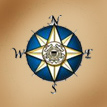
| Lost in Mongolia | |
|
There is probably no other country on earth that is so easy on your eye. Endless steppe with the distant rolling hills, with no roads or fences, and occasional white dots of gers makes your mind wonder careless and free. The first encounter with this amazing country for most people happens to be in Ulaan Baatar (red hero), the modern capital of Mongolia. While circling above the airport, the pilot's announced that the temperature on the ground was over 30C. That sounded a bit unusual for the Mongolian summer. The plane landed with a loud thud. 'Welcome to Mongolia!' I said to myself. As I stepped outside, a hot and dusty wind hit me in the face reminding me that after all, this country's substantial territory is a part of the Gobi desert. The winds carry sand and dust for thousands of kilometers, even reaching as far as South Korea to the east. Even though it was getting dark, I could make out the unattractive shapes of Soviet era buildings on both sides of the road. And here's our hotel to the right as an example. |
 |
 |
The sun rises early during summer in Mongolia. At 6am it is very bright outside. And even if the light won't wake you up, the sounds of car horns and loud voices on the street sure will. The breakfast was simple but tasty and the hotel’s restaurant was clean and tidy. Chatting with the fellow tourists provided some insights into what brought them to Mongolia and provided a lot of inspiration. Some of them were well over 70 years old. As our hotel was located in close proximity to the city centre I proceeded to explore on foot. The first destination, Suchbaatar Square, was easy to find. The streets got wider and the buildings more prominent. I had no plan in particular and circled around the city hall and then the Government House (Saaral Ordon) that faced onto Suchbaatar Square. To my surprise the large square was almost empty; a small group of tourists and few locals were dwarfed by the stature of Suchbaatar, the local hero. |
|
Slowly proceeding to the centre of the square, I was approached by a semi-sober Mongol, well in his sixties, with his hands outstretched showing me a variety of cheap souvenirs and some stamps from the days long gone. He did not speak much English but got quite chatty when I spoke to him in Russian. He's explained to me that vodka cost a lot of money and he had to sell quite a few souvenirs to get his daily intake - 'opohmelitsya'. |
 |
| Ulaan Baatar Black Market | |
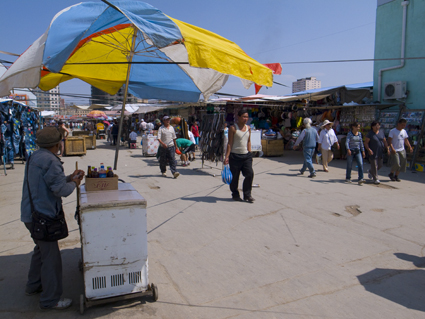 |
Forewarned is forearmed. Markets are more than just a place to buy things. They give one a sense of culture, a vision of how people live and what they use in their daily lives, and often what they eat as well. Being warned about pickpockets at the infamous Ulaan Baatar’s Black Market, I have still decided to visit it and be on guard. Going alone is not necessarily a bad thing. The advantages are that you are not being distracted by your companion and that you can move quickly in any direction without worrying about someone else being left behind. Some parts of the market were wide open spaces where one could find a full ger building kit or a row of bicycles. The rest of the market consisted of narrow covered passages, where you would need squeeze yourself between other shoppers. Only a very small section of the market is dedicated to what tourists might consider souvenirs, underlining the fact that this market is primarily aimed at locals. I was amazed at that market, and later on in the rest Mongolia, by the way the sellers behaved towards me. Nobody tries to seek your attention or advertise their goods to you. Only if you start looking at objects closely do they then offer to help. I find it very unusual for an Asian market. Maybe it relates to a national pride or some Mongolian custom? |
| Arburd Sands | |
| The first destination, Arburd Sands, has been a dreamy experience. For the first time, since leaving Ulaan Baatar, you start to take in Mongolia. Whether it is a fresh unpolluted air, the smell of grasses and wild flowers, the breathtaking scenery of open plains and its crispy blue that seems to be infinite sky. The Arburd Sands lie right on the edge of the Mongolian steppe where it meets the Goby desert. The first camping stop was at a ger camp that has been setup semi-permanently by a local family to cater for visitors. Interestingly, the life of this family has been depicted in Mattias Klum’s book the “Horse People”. |
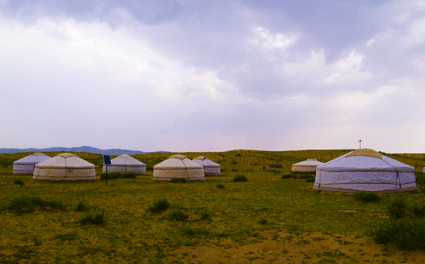 |
 |
For those who feel adventurous, a choice of either a horse or a camel ride was available. Do I hear being asked about safety? What safety? You might be lucky to get a helmet that actually fits and if it does fit, it might not have a strap for your chin. |
|
The scenery around the camp was typical for Mongolia, wide endless steppe with occasional treeless hills. The lack of tree is mainly due to the harshness of the local climate where only the toughest, the most cold and heat resistant plants survive. While walking around, it pays to watch where you step as the earth is often pocked with burrows dug by small rodents amongst the grass. The holes of various sizes are often spread over a large area. |
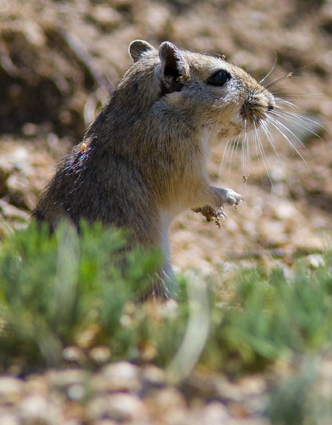 |
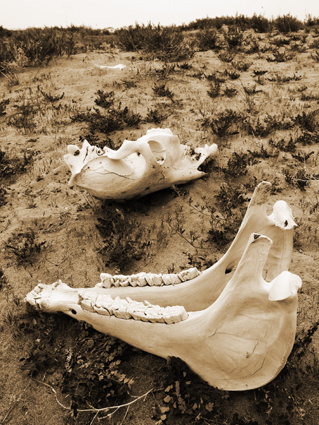 |
It is also quite common to find on the ground a skeleton or a skull of a horse or some other unfortunate animal. The white bones stand out clearly against the dark soil and grass. |
|
The presence of the desert was obvious. Just over a hill the sand started taking over the grasslands and typical desert spiky plants started to crop up everywhere. Gradually, the landscape changed even more to occassional rocks and picturesque sand dunes. | 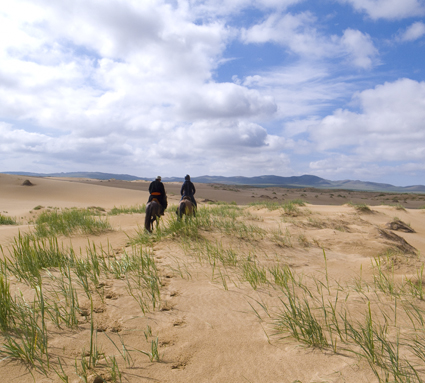 |
 |
Anywhere you go, there was a constant presence of birds of prey, like falcons, kites, vultures and occasionally eagles. They would circle around our campsite and hover over; sometimes getting so close that you could clearly see the delicate features and colourful feathers of these gracious birds. Every morning the sun would rise early, around 5:30am, and even if it was raining the night before, the sky was usually azure blue and often complemented by shaggy white clouds of various shapes and sizes. This same morning, I have chosen to go for a horse ride. I have to say it was the best horse ride ever. The Mongolian horses, despite their small statue, are quite strong and fast. Some have a bit of a temper. When tied up they are kept apart to avoid injuring each other. Riding on a horse in open steppe gives you a sense of freedom. The open plains of Mongolia without any fences and hardly any trees is a perfect setting for making you feel as though you are flying. A feeling of wind on your face and a smell of wild flowers completes this extraordinary experience. |
| Visit to Local Family | |
|
A couple of kilometers away from our camp a nomadic Mongol family had setup their camp. We have paid them a visit to observe their daily life, say hello and get a sense of what it really means to be a nomad. Amazingly, they had a satellite dish outside their ger along with some solar panels. We’ve been invited to come inside their ger. Everyone was offered a salty tea with milk and a bit of aruul (dried goat's cheese curd). I liked both. But not everyone in our group agreed with me. The ger had traditional settings, with the large chests positioned opposite to the entry, and a small stove in the middle with its metal pipe stretched up through the opening in the ceiling. In the absence of wood, dried horse dung is used to feed the fire and cook food. Traditionally after the visit, we have left some presents in the ger for the family. |
 |
| Baga Gazriin Chuluu | |
 |
The next stop was in a picturesque location of Baga Gazriin Chuluu. The rocky cliffs formed ridges that sliced the valley into two almost identical canyons. The camp site has been set up in one of these canyons to provide shelter from the wind. This mountainous region is supposed to be a home to the Siberian Ibex. We only saw a silhouette of one far in a distance while driving towards this area. On a way to Karakorum The itinerary has been amended slightly and our next stop was in a beautiful valley surrounded by mountains. We camped there overnight. The high cliffs provided good vantage points for various birds. A large vulture nest with its occupants was seen from the bottom of the cliff. A couple of colourful ovoos were also spotted around giving the valley a bit of a mystical feel. A pack of horses grazed in the open and constantly moved up and down the valley during our stay. |
| Karakorum and Ergen Zu monastery | |
|
The ancient capital of Mongolia was called Karakorum and was created by the descendants of Ghengis Khan. The city no longer exists but the nearby buddhist monastery of Ergen Zu was build from its remains. The monastery is beautiful and now it serves as an open air museum. Outside of the monastery, if you are brave, you can hold a hunting eagle wearing a protective glove. |
 |
 |
After a long drive from the monastery we arrived at a very windy location near a fast flowing river. The grass was full of bones, rocks and manure. A large warm bonfire and traditional Mongolian singing provided the night's entertainment. |
|
The following day we camped next to another small river. Being able to wash yourself felt like a luxury. Who cares that the water was cold? There were quite a few Mongol families living in the area in gers. The horses and yaks always grazed nearby. From time to time a Mongol shepherd could be seen riding on a horse through our camp to herd the yaks. |
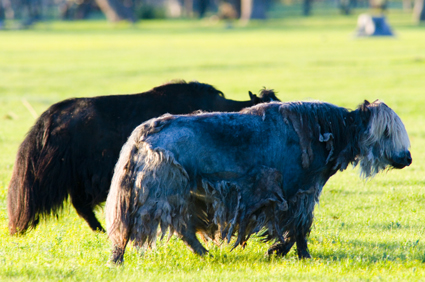 |
| Chuluut Canyon | |
 |
This rugged and deep canyon is located on the Chuluut river which we travelled along to reach our next camping site. The fast rapids made a rumbling noise familiar to anyone who has ever experienced mountain rivers. The sides of the canyon were covered in bush and rather tall spruce trees. Our next camping site was at a scenic location on a slope half way between the main road and the river. The spoon shaped area looked like it had a major geological event occur. Perhaps a glacier moved through here carving its way through the rocks and eventually melting away. In the next couple of days we have passed a couple of salt lakes. The amazing thing is that those lakes look quite ordinary and on some occasions you can spot some water birds there. But the water, however, is not drinkable and animals tend to avoid this sort of lakes. There is an abundance and a variety of insects in meadows surrounding lakes and rivers. They crawl, jump and fly, and make all kinds of noises. |
| Horgo Volcano | |
| The first extinct volcano we've climbed was in the Horgo national park. Here is the view on the volcano's caldera with a lake in a distance. |
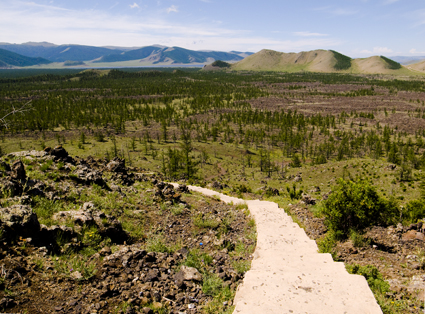 |
| Great White Lake (Terkhiin Tsagaan Nuur) | |
 |
This beautiful wide freshwater lake attracts a lot water birds. While driving past we saw majestic swans, wild ducks, cormorants and some others, the names of which now escape me. The water was crystal clear and some daredevils had a bit of a splash and swim. Fishing in the lake proved to be fruitless, however. The scenery was so splendid, it was an enjoyable experience just to be around. The distant treeless hills contrasted against the blue sky and an occasional white cloud. When the sun was setting, some of the hills on the opposite side of the lake started to glow in a warm orangy-pink colour. |
| Lake Khovsgol | |
|
After a long drive we have finally arrived to this magnificent lake in northern Mongolia. The closeness of Siberia makes itself known by the presence of patchy forests and more rugged terrain. The forests are primarily of spruce and silver birch. Lake Khovsgol seems to be a popular location as there are permanent tourists camps setup on the lake's shores. Some areas around the lake are protected and have limited access. According to Wikipedia Khovsgol lake is "the second-most voluminous freshwater lake in Asia, and holds almost 70% of Mongolia's fresh water." The water in the lake was so clear, one could see through the water to a great depth. The campsite we stayed in was a permanently setup fenced area with stationary gers, a wooden building with showers, laundry and toilets. The gers had small iron heaters. Once you get the fire going it gets very hot inside the ger probably due to its rounded construction where some of the heat gets reflected back. We stayed at the campsite for two days. That gave us an opportunity to explore the local hills on horseback. The little Mongolian horses carried us up the steep hills with ease, carefully navigating among fallen trees and loose rocks. Once we have reached a top of one of the hills, a magnificent panorama opened up before our eyes. Right in the middle of the lake there was either a large island, or a peninsula, with heavily overgrown forest. Its narrow banks were covered with grey rocks. Earlier on, a few from our group have chosen to row an old dinghy across the lake to the other shore. The dinghy has seen better days and its oars' ends were made of spades. While rowing, the boat was never going straight but always curved to one side. Nevertheless everybody enjoyed the experience. |
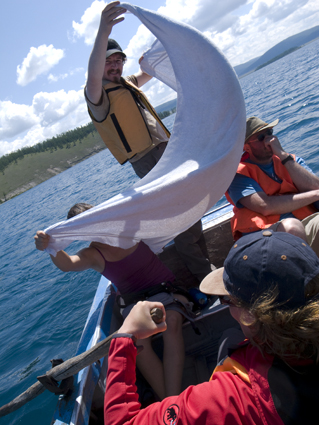 |
| Naadam Festival | |
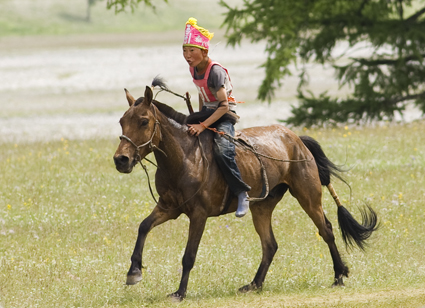 |
One of the highlights of our trip was visiting Naadam festival. It is celebrated across the country in the middle of July. We were lucky to attend a celebration in one of the smaller towns we have visited. It was an opportunity to get closer to the locals, to see their traditional dresses, horse races and a wrestling competition. The day was nice and bright and the temperature quite warm. The festival took place in a wide area where large tents were put up by the organisers. The wrestling arena was about 50m long and 20m wide has been set up in the centre with the stretched rope marking the area to form a stadium. Spectators could either stand or sit on small thin benches outside the marked area. The wrestling has been going on for hours. It started with wrestlers being introduced to the crowds. All of them performing some kind of a slow dance with arms stretched out and knees slightly bent. Most of the them were wearing Jodag (a light blue or red jacket) and Shuudag (small tight-fitting briefs). Not far from the arena were two rows of sellers having placed their goods on the ground on thick rugs. They were selling various objects made from wool, souvenirs, jewellery and decorative bits and pieces made of wood, bone and horn. The festival's atmosphere was a celebration of national culture and pride. One had to watch out for the horse riders, mostly young kids, that moved around in the crowds like that was the most natural thing to do. At some point in time there was an excitement in the air and people started moving towards another area. That appeared to be the finishing line for the horse races. Kids, some as young as 6, galloped in on the horses with lots of yelling and screaming. |
| Selenge River | |
|
Due to time constraints we made only a brief stop near this famous river. It is a main river in Mongolia, crossing the the border with Russia it flows into lake Baikal. Where we stopped the river was quite fast flowing and perhaps only a 100 meters across. As with many rivers in Mongolia the river bed was rocky and the shores free of trees and bushes. Following our group's established tradition some brave people took their shoes off and entered the river, carefully balancing on slippery rocks. | 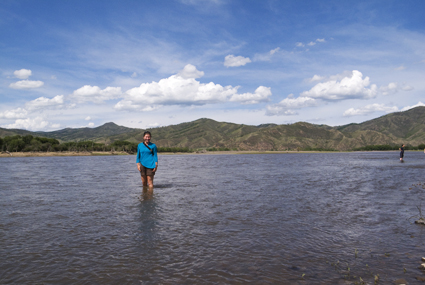 |
| Amarbayasgalant Monastery | |
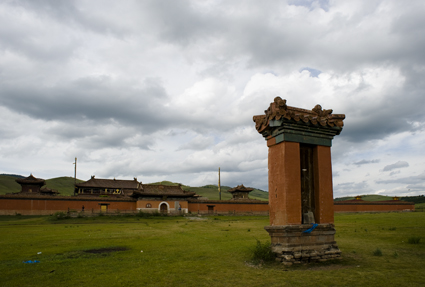 |
I have seen a lot of Buddhist temples and monasteries, but this was certainly different. Probably more real. The buildings looked quite old and neglected. There was grass growing on the roof tops. The thing that striked me the most was an abundance of birds; pigeons, crows, magpies. They were circling above, making loud noises assuring visitors that they were the main inhabitants of this ancient place, not people. On entrance of any of the temples one is greeted with a strong incense smell. And no wonder. Everywhere along the buildings there was drying wood in stockpiles. This sort of wood is used to make incense sticks. While carefully walking amongst the building taking in the unforgettable atmoshpere of this monastery, you see bands of ground squirrels occasionally popping up from cavities in the walls and holes in the ground. They are totally unafraid of humans and come as close as a couple of meters from you. Unlike many religious places around the world and especially in Europe Buddhist monasteries in Mongolia seem to be left to the forces of nature and show a state of neglect. Or maybe it is just a part of the Buddhism teaching to leave things to integrate into their environment? |
| Conclusion | |
|
Coming back to Ulaan Baatar was as exciting as it was sad. The excitement was about coming to a finishing line and looking forward to a hot shower. But feelings of sadness were prevalent among the group. After almost 3 weeks in the wild there was a strong bond between everyone in the group. Despite the harsh conditions everyone was trying to help other who were in need or simply to cheer them up or offer a snack. Coming back to civilisation with all its complexities was quite hard for me. I kind of liked the simplicity of life we had, worrying only about putting the tents up, having something to eat and not getting lost. Complements to our cook and her assistants the food was always excellent and plentiful. Bayartai Mongolia! |
 |
| Miscellanous photos | |
| What's cooking? | Decision time |
 |
 |
| Village supermarket | Typical village houses |
 |
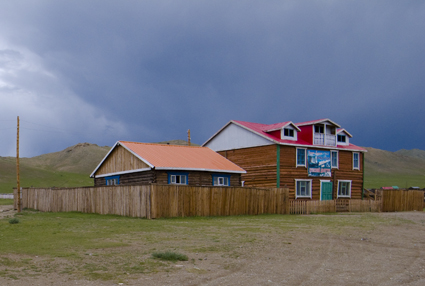 |
| Empty bus crosses wooden bridge | Puzzle for the reader... Guess what this is on the photo below? |
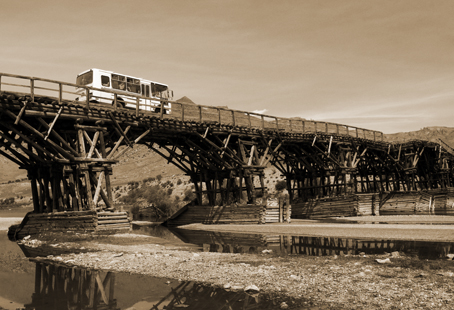 |
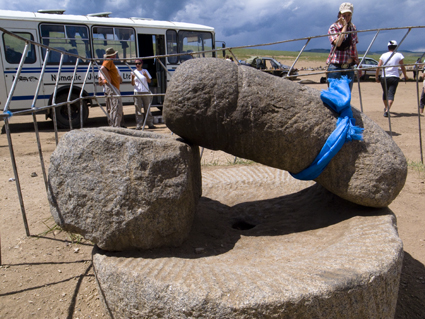 |